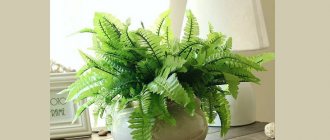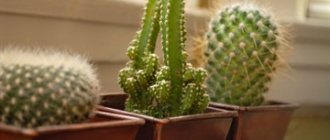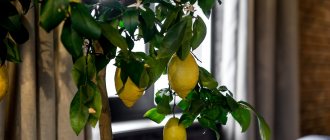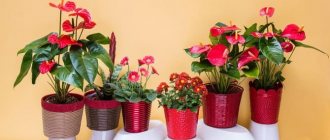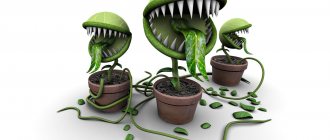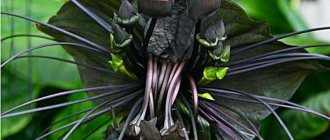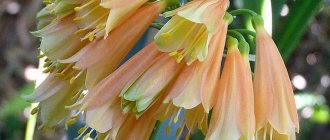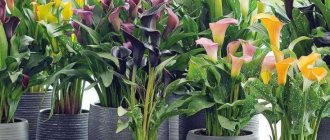The 15 best indoor flowers you should have in your apartment. Read the article about why and how they affect a person.
Indoor flowers bring beauty and comfort to your home. It’s hard to argue with this, but in order for plants to feel good, they need to find optimal conditions for existence. Choosing a location is one of these conditions.
Read an article on our website about how to properly replant an indoor flower in a pot . You will find out what reasons there are for this and what is necessary.
What indoor flowers should be in the house, and which ones are not advisable to have? Where should they be? Find answers to these and other questions in this article. Read on.
Where and how should indoor flowers be placed: according to Feng Shui, in the children's room, kitchen, bedroom
Indoor flower
It is clear that when a new flower appears in the house, the housewife tries to find the best place for it, i.e. so that it does not interfere with the inhabitants of the apartment or house, and, at the same time, it can be constantly admired. But the location of the flower can also enhance or, conversely, reduce the influence of certain aspects of life and the energy that is present in the home. Where and how should indoor flowers be placed?
To create positive energy, you need to follow several not very complicated rules according to Feng Shui:
- There should be no artificial flowers in the house - they have very bad, one might even say dead, energy.
- The same can be said about flowers that show signs of wilting - their influence will negatively affect the inhabitants of the house, they are immediately removed.
- Indoor plants in the bedroom can negatively affect marital relationships because they enhance the yang energy in the room.
- It is forbidden to place flower pots in open spaces ; their place is on special shelves or niches, where energy is retained and distributed throughout the space.
- Relaxation areas seem to be specially designed for admiring flowers , but they do not need to be placed directly next to the sofa or lounge chairs. It is better to place them so that they are clearly visible, but at a slight distance.
in a children's room because there is a high risk of injury to the child if the pot turns over. In addition, some flowers may contain toxic substances in their leaves or stems, and children, out of curiosity, may chew a leaf and become poisoned.
The kitchen is a good place for flowers, but only if it is large enough. Otherwise, the hot air from the stove may damage the plants and they may die. On a kitchen window sill, large plants will shade the room, but small pots of violets or cyclamen are quite suitable for decorating window sills in this room.
What factors influence
The microclimate in the house is influenced by both external and internal factors. External factors include the location of the premises, the change of season, the technical parameters of the structure, humidity and atmospheric air pressure.
Subjective factors largely depend on the residents themselves. People are able to independently maintain comfort in their home by performing a number of specific actions in a timely manner.
So, to save heat, it is enough:
- Replace old frames with energy-saving double-glazed windows or carefully seal cracks in old structures.
- If necessary, insulate the walls of corner rooms.
- Lay a warm floor covering or install heated floors.
- Add a heat reflective screen to the wall next to the radiator.
- Do not cover radiators with furniture or thick curtains.
- If possible, insulate the loggia and front door.
Climate
The start dates of the heating season over the vast area of Russia differ greatly depending on latitude. To draw up heat supply schedules, average winter time values are taken from a special temperature table. For the southern territories they are one, and for the northern territories they are different.
For example, in the Nenets Autonomous Okrug the heating season begins in September, and in the Moscow region - only in early October. In the Krasnoyarsk Territory and Chukotka, residents will begin heating their apartments at the end of August. For residents of the Black Sea coast, heat is supplied for only three months, starting in December.
There are places in the Russian expanses where it is necessary to warm up houses throughout the year, for example, on the polar island of Dikson.
Season
The change of season also affects the microclimate of the home. With the onset of dank and rainy autumn weather, the walls of houses heated over the summer gradually cool down. In the spring, when the heating is turned off, room thermometer readings also decrease.
Building Features
The technical characteristics of the building, its thermal insulation, materials - all this affects the microclimate of the home. For example, each additional corner in the house is a separate cold area that requires additional heating.
A brick building is warmer than a panel building with seams, and wooden houses not only keep heat well in winter, but also provide pleasant coolness in the summer.
Human factor
The human factor plays an important role when choosing a comfortable thermal regime. For example, some people prefer a warmer atmosphere, while others prefer cooler air.
Many people open their windows to bring in fresh air even in the winter months, and use air conditioning in the summer heat. This lowers the degrees by several units.
Indoor flowers that must be in the house: 15 best flowers for home and apartment
Experienced flower growers know that some flowers have a good effect on the energy and atmosphere of a home and a person, while others are best avoided and not planted in a living room. This is due to various factors, including the fact that plants can be simply poisonous and emit substances harmful to humans or domestic animals. Below you will find a list of indoor flowers that must be in the house. These are the 15 best colors for home and apartment:
Aloe is an indoor flower that must be in the house
- ALOE
This green plant is not very impressive in appearance, but its benefits significantly outweigh this drawback. This is a medicine flower. With its help you can cure colds and inflammations, heal wounds, and stop bleeding. It has a very good effect on the skin. Therefore, it is often used in cosmetology; it is part of cosmetic masks for aging skin.
Violet is an indoor flower that must be in the house
- VIOLET
A little was said about this plant above, but it is used not only for beauty. It can quite effectively clean the kitchen of carbon monoxide, and slightly humidify the dry air. The wide palette of colors of modern varieties of violets even relieves depression.
Geranium is an indoor flower that must be in the house
- GERANIUM
The lush greenery of this plant and highly decorative flowers have made it popular among gardeners. Geranium can also rid your home of moths and pathogens. Fragrant inflorescences will help with headaches and relieve nervous tension, helping you to sleep peacefully.
Crassula is an indoor flower that must be in the house
- PASSIONATE
Or money tree - this plant is more familiar under this name. It is called so because of the similarity of the small round leaves with coins. The stems of the crassula are densely hung with these “coins”. Because of this, it is believed that the plant can attract banknotes.
Citrus fruits are indoor flowers that must be in the house
- CITRUS
A blooming lemon or orange is simply a fantastic sight, not to mention the amazing aroma of the flowers. True, only owners of fairly large kitchens can afford such a luxury - citrus fruits in adulthood are quite large plants. The fruits and leaves release essential compounds that can relieve stress and soothe irritation.
Anthurium is an indoor flower that must be in the house
- ANTHURIUM
When people see this flower for the first time, they confidently say that it is artificial. The spectacular red inflorescence seems to be made of plastic. Beautiful dense leaves, if they are healthy, also look like artificial ones. But these leaves can absorb harmful impurities released by modern finishing materials.
Calla is an indoor flower that must be in the house
- CALLA
A bouquet of these graceful flowers is often held in the hands of the bride at a wedding ceremony. Now varieties not only of white, but also of other colors have been bred. But only the white calla is a royal flower. It can be grown at home on a windowsill, although only experienced gardeners can do this.
Camellia is an indoor flower that must be in the house
- CAMELLIA
An elegant, but rather capricious flower that requires special attention. The inflorescences of this plant resemble miniature peonies. Shiny leathery leaves add decorativeness to the entire flower. This is an infrequent guest in apartments, due to its demands on environmental conditions.
Kalanchoe is an indoor flower that must be in the house
- KALANCHOE
Another “family doctor” who helps to cope with certain diseases. Only, unlike aloe, it belongs to a different family - Crassulaceae. Some species are so decorative that they began to be sold in bloom, along with miniature roses, orchids, and azaleas, at New Year's flower shows.
Cyclamen is an indoor flower that must be in the house
- CYCLAMEN
Another frequent guest at New Year and Christmas flower sales. It blooms mainly in winter with beautiful, butterfly-like flowers in delicate shades of pink. The difficulty in keeping this flower lies in preserving it during the dormant period, which occurs in the summer, when the flower must be stored at low temperatures.
Orchid is an indoor flower that must be in the house
- ORCHID
For some flower growers, this is a real antidepressant, capable of distracting a person from negative thoughts and giving joy simply by its presence. One of the best indoor flowers with very high decorative flowers and leaves.
Dracaena is an indoor flower that must be in the house
- DRACAENA
Feng Shui experts often recommend having this flower at home. He is able to accumulate positive energy and give it to his owner. Quite unpretentious in maintenance, but rarely blooms, but has decorative leaves.
Monstera is an indoor flower that must be in the house
- MONSTER
Large flower for large rooms. The leaves require constant attention - they need to be frequently wiped with a damp sponge, sprayed, and watered. But the plant is majestic, it gives a feeling of being in the jungle, where, in fact, it came to us.
Azalea is an indoor flower that must be in the house
- AZALEA
A flower that loves cold and shade. Having created such conditions, you can admire its spectacular flowering for a long time. But this is difficult to achieve in summer. Therefore, the plant is not very popular and you rarely see it on windowsills or shelves. Although experienced gardeners grow azaleas and are not going to give them up.
Fern is an indoor flower that must be in the house
- FERN
It has decorative foliage, never blooms, and reproduces only vegetatively. Several types of fern are grown at home. This plant does not like heat or direct sunlight; it needs to be sprayed frequently to increase the humidity of the surrounding air. Such conditions are comfortable for him, and he can live in the apartment for decades.
Azalea
Azalea pleases its owners with delicate buds that bloom even in winter. Its mesmerizing flowers come in a variety of colors - from snowy white to lilac and dark red. Against the background of windows painted with frost, they look simply amazing and create a special aura in the house. The plant sometimes blooms so profusely that even the leaves are not visible behind its flowers.
Azalea smoothes out conflicts, reduces the level of aggression, even in animals, removes nervousness, and relieves fatigue. To get into a positive mood, sit next to this flower. You will feel how it relieves tension, takes away worries and worries, makes your thoughts cleaner and calmer.
Azalea relieves eye fatigue, eliminates inflammation caused by both insomnia and long hours of work at the computer, and even, according to experts, improves vision. And the petals of the plant are used to treat stye: they are secured with a bandage on the inside of the wrists for 5-6 hours.
For people of creative professions, azalea gives inspiration, a sense of self-confidence, faith in one’s own strength, and helps to cope with anxiety in important situations. Plants with dark red flowers repel moths, house ants, tree beetles and other small pests.
What flowers should not be kept at home: prohibited list, reasons
Now you know which flowers to give preference to when growing them in the house. But you should also know about plants that are best not kept at home. There can be many reasons for this, ranging from the negative energy that affects people to the harmful substances released. What flowers should not be kept at home? The reasons are described below. Here is the prohibited list:
Oleander - should not be kept at home
- OLEANDER
All parts of the plant are poisonous - leaves, roots, and flowers. Although the plant during the flowering period is very decorative and emits a strong aroma. It also does nothing good for human health. On the contrary, inhaling the smell of oleander, you can feel dizzy and decrease in overall well-being. And if the juice of this plant accidentally enters the human body, it can cause visual impairment.
Alocasia - should not be kept at home
- ALOCASIA
In alocasia, just like in oleander, all parts are poisonous. But thanks to its large arrow-shaped leaves with pronounced, light veins, it is quite well known to flower growers. It is grown mainly in offices, but is usually placed in inaccessible places so as not to cause accidental poisoning.
Dieffenbachia - should not be kept at home
- DIEFENBACHIA
A fast growing plant with large beautiful leaves. It looks like a small tree. The leaves are poisonous. If the juice gets into the oral cavity, life-threatening tissue swelling may develop. Therefore, it is forbidden to keep it in an apartment where there are small children and animals.
Ficus - should not be kept at home
- FICUS
This plant should not be kept in an apartment due to the fact that it actively absorbs oxygen from the surrounding air. There’s not much of it in houses anyway, so there’s no need for a competitor in this matter. In addition, this is a fairly large plant, it needs to be looked after to ensure that the leaves always look healthy and shiny.
Gloriosa - should not be kept at home
- GLORIOSA
A plant with unusually beautiful exotic flowers. But it is forbidden to keep it at home because of its poisonous juice, which can even be fatal. The seeds and roots of the plant are also dangerous. Gloriosa toxins cause severe vomiting and can lead to kidney failure. Therefore, it is better to abandon such a plant.
Beneficial properties of house plants
Here are the main ones:
- Carbon dioxide accumulates in poorly ventilated rooms. Flowers absorb it and saturate the air with oxygen.
- Medicinal plant species treat cuts, burns, colds and other ailments.
- In winter, indoor air becomes dry due to the heating system, which affects the condition of the skin and well-being. Flowers help humidify the air.
- Plants absorb electromagnetic radiation that is created by household appliances and home appliances. It can affect a person’s well-being, causing insomnia and headaches.
- We are surrounded by objects that can release toxic substances. City air contains a lot of dust, exhaust gases, and heavy metals from emissions from factories and enterprises. Plants purify the air, kill microbes with the help of their phytoncides and absorb harmful impurities.
- Popular beliefs give indoor flowers the properties of bringing happiness, harmony, tranquility, etc. We included in our review some plants that, according to signs, are useful for their owners.
How long should a phytolamp for indoor flowers work?
Phytolamp for indoor flowers
One of the main characteristics of indoor plants is their attitude to light. On this basis they are divided into 4 groups:
- Sun-loving plants - aloe, ficus benjamina, cyperus, coleus and others.
- Light-loving plants - dracaena, Kalanchoe, cyclamen, citrus fruits, geranium.
- Shade-tolerant - anthuriums, ferns, some orchids, etc.
- Shade-loving plants - monstera, oxalis, indoor grapes, etc.
Based on this, you can determine how many hours a day certain indoor plants should be illuminated. How long should a phytolamp for indoor flowers work?
- One important point should be noted right away - even sun-loving plants should not be provided with round-the-clock illumination.
- At night, all flowers undergo important processes that cannot take place in the light.
More details:
- Sun-loving plants should be illuminated at least 4-5 hours a day in winter.
- One hour in the morning and the rest in the evening, i.e. They turn on the lights at 7 a.m. and turn them off at full sunrise.
- In the evening they turn on at dusk and turn off at 21:00 . It is clear that the flowers should be on the windowsill or in close proximity to the window.
Worth knowing:
- For those who love light , this time can be reduced by an hour or an hour and a half, while their location can be determined at a distance of no more than 1 m from the window.
- For shade-tolerant and shade-loving flowers, turn it on in winter, for example, in December - for no more than half an hour. Shade-loving flowers are placed at a distance of 3-4 m from the window, and shade-tolerant ones can be placed in the darkest corners of the room.
Now you know which flowers you can plant and which you shouldn’t. Don’t forget to turn on the phytolamp, especially for light-loving plants that lack warmth and light in winter. Good luck!
Indoor plants with good, positive energy: list
Many plants have positive energy.
List of plants with good energy:
- Begonia. This culture has a beneficial effect on the body. It is recommended to place begonia in the room of children and elderly people. It helps restore the immune and nervous systems. A pleasant aroma cures depression.
- Lemon. It is a symbol of friendship and cheerfulness. Thanks to this plant you can lift your mood and increase your vitality.
- Hyacinth. This plant fills the house with emotions. With its help you can improve your well-being and achieve harmony. In addition, it will be possible to improve relationships between family members.
- Hibiscus. This is one of the varieties of rose. With its help, you can restore your old relationship with your other half. Place a flowerpot with a plant in the matrimonial bedroom.
- Cyclamen. This plant disciplines and teaches order. Culture enhances creativity.
- Dracaena. This plant has been known since the times of Ancient Egypt. Culture improves memory and helps get rid of depression.
Indoor plants with good, positive energy: list
